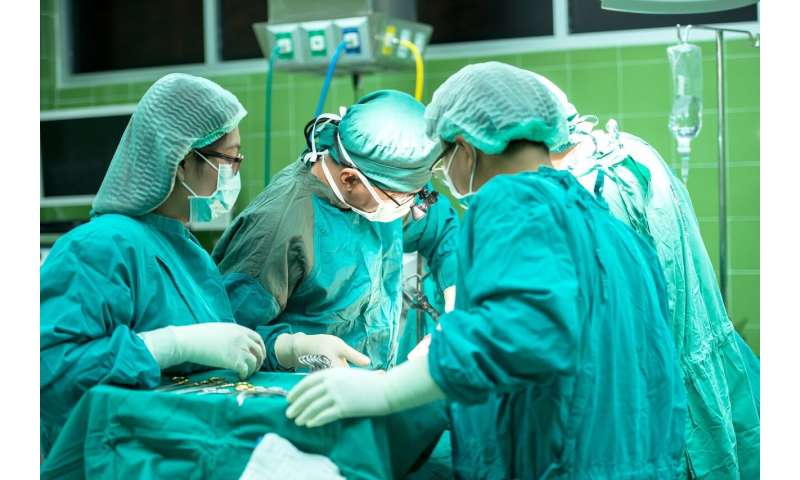
The direct oral anticoagulant rivaroxaban dramatically cut the likelihood of serious venous thromboembolism (VTE) in people recovering from lower limb orthopedic surgery requiring immobilization in comparison with enoxaparin, another anticoagulant agent, according to research presented at the American College of Cardiology’s Annual Scientific Session Together with World Congress of Cardiology (ACC.20/WCC).
The new data revealed that rivaroxaban cut the risk of major VTE by 75% without increasing the risk of bleeding, a common concern in patients taking a blood thinner. This international, double-blind, randomized controlled trial is the first to compare rivaroxaban against enoxaparin, a low molecular weight heparin, for clot prevention in people recovering from non-major orthopedic surgeries who often must restrict movements of the affected limb for a period of time to promote healing. However, even a brief period of reduced mobility can heighten a person’s risk of developing dangerous blood clots that can lead to deep vein thrombosis (DVT), a condition where clots form in the veins of the legs, or pulmonary embolism, when clots travel and get lodged in the lungs.
“We must prevent VTEs in these patients because some can lead to pulmonary embolism, which can be fatal,” said Nadia Rosencher, MD, senior consultant and anesthesiologist at Paris University, France, and one of the study authors. “This study represents a major step forward in our treatment of patients after many orthopedic procedures because it proves that we can more effectively prevent thrombosis with a once-daily oral medication versus a daily injection with the same safety.”
Rosencher said taking injections of enoxaparin can be very cumbersome for patients, who sometimes require a nurse to help administer the medication. Additionally, this is a young population with a median age of 40 years, who often need to get back to work or caring for a family without added complications.
Rivaroxaban works by blockingthe activity of the clotting protein factor Xa. It’s known to be a strong anticoagulant, so researchers said they were somewhat surprised and reassured to find that bleeding risk was the same as with enoxaparin.
While most contemporary clinical guidelines recommend using anticoagulants to prevent blood clots after major orthopedic surgeries, including total knee and total hip replacements, that put patients at higher risk for VTEs, there is less agreement about prophylactic thrombosis treatment in patients at moderate risk for clots—for example, those undergoing ankle surgery, ligament repair or knee arthroscopy. Millions of people in the U.S. undergo these procedures each year and may need blood thinning to prevent clots from forming.
“In Europe, all the guidelines agree that some level of thromboprophylaxis should be given, but overall there is no agreement on what should be done for the patient population who remains at moderate risk for clots because of being immobilized during their recovery,” Rosencher said. “In many ways these data are a win-win for patients—a pill with no jump in major bleeding events.”
The study included 3,604 patients from 10 countries who were deemed to be at moderate VTE risk post-surgery by the investigator. Patients had to be immobilized for more than 15 days to be included. Patients were randomly assigned to receive rivaroxaban (10 mg once daily by mouth) or enoxaparin (40 ml once daily by subcutaneous injection). Because it was double-blinded, all patients received an injection and a tablet, so people in the rivaroxaban group took a daily pill but also got a placebo injection. Overall, patients had a median of 28 days of reduced mobility—1 in 3 were immobilized for one to two months, and 2 in 3 had to restrict activity for two weeks and up to one month.
The primary efficacy outcome of major VTE was the composite of symptomatic distal or proximal DVT, pulmonary embolism or VTE-related death during the treatment period and follow-up for one month, or asymptomatic proximal DVT at the end of treatment, which occurred in 4 out of 1,661 patients (0.24%) in the rivaroxaban group and 18 of 1,640 of patients (1.1%) in the enoxaparin group. Prespecified secondary outcomes were major and clinically relevant nonmajor bleeding, defined based on other studies, overt thrombocytopenia (low platelet count) and death from any cause. Bleeding rates did not differ between the rivaroxaban and enoxaparin groups (1.08% and 1.04%, respectively, for major plus nonmajor clinically relevant bleeding; 0.57% and 0.69%, respectively, for major bleeding). There were no deaths in either arm except one that occurred at the end of study follow-up and after a liver transplant.
“We saw a high number of patients in the low molecular weight heparin group with proximal asymptomatic DVT by compression ultrasounds, and these are quite dangerous as they can lead to pulmonary embolism that carries a high death toll,” Rosencher said. “We expect to see expanded indications for rivaroxaban in other patients based on these data.”
Rivaroxaban is currently approved by the U.S. Food and Drug Administration to prevent DVT that may lead to a pulmonary embolism after electivekneeor hipreplacement surgery; in some countries, it has a broader label to include use after lower-limborthopedicsurgery.
Source: Read Full Article